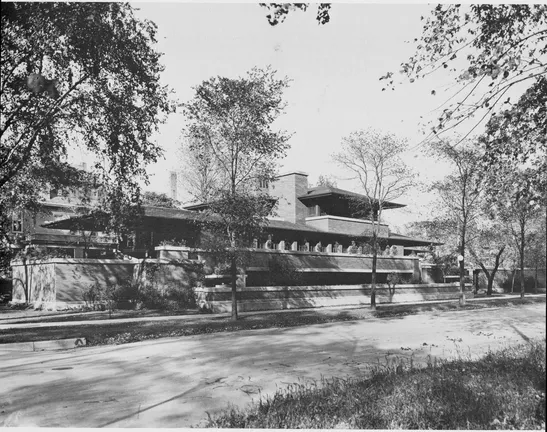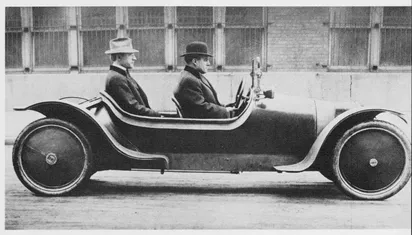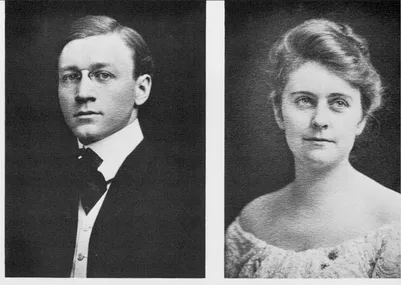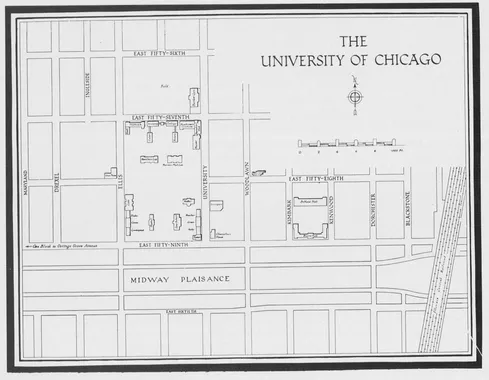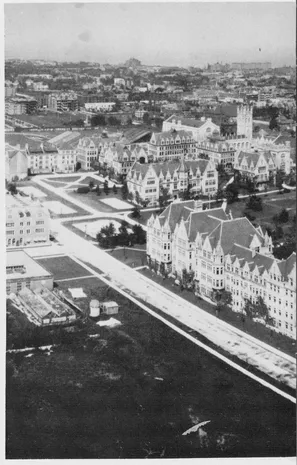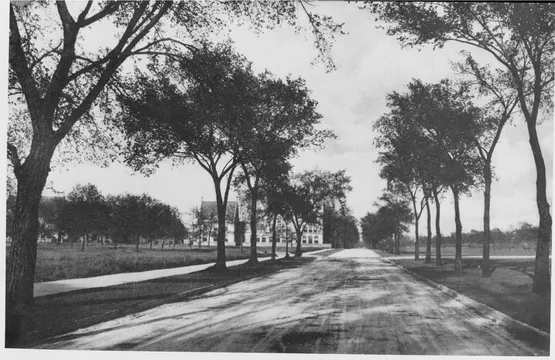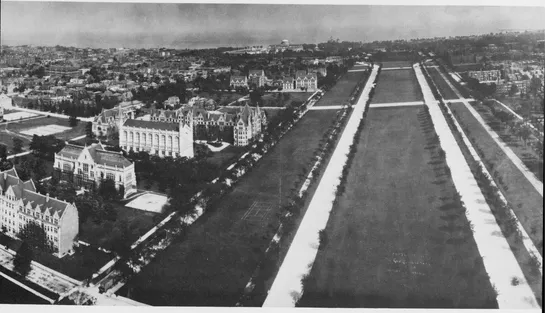![]()
2. Robie’s house at 5757 Woodlawn Avenue, Chicago.
Chapter I
FROM CLIENT TO ARCHITECT
Fred C. Robie liked to ride around Chicago, the city where he was born, in an experimental motorcar of his own making. It was streamlined and snappy, a more sensible car than most of those on the streets today. If the “Robie Cycle Car,” as he called it, never quite got into production, at least it said that its owner chose not to be taken as an ordinary man [Fig. 1]. Robie had every reason to think that he was going places. His new house in Hyde Park looked very much as if it might be, too [2]. It was sure to be seen someday as a consummate expression of the ideas and ideals of its architect, Frank Lloyd Wright. It was destined to be one of the most famous houses of America and one of the most famous houses of the twentieth century, anywhere.
Wright had come into his own a few years earlier, just at the turn of the century. The calendar itself must have cried out to such a radical spirit for full proof of good works in the cause of modernism. In 1902 a young man named Francis Barry Byrne went to work for Wright in his Oak Park studio, at the west edge of the city. Byrne stayed until the summer of 1908, not long before Wright planned the house for Robie. As an old man, Byrne loved to look back to that time:
The years I worked under Frank Lloyd Wright were those which saw the emergence of that greatest of his contributions to a living architecture, a unique, vital, and relevant building plan which was to become a source factor in European modernism, and the unification of this vital plan with an equally vital building mass and detail. It was a period which marked the passing from his work of Sullivanesque remnants and the appearance of his own uniquely beautiful architecture in relative completeness. The culmination of this happy period in his life as an architect was the Robie house.1
1. Fred C. Robie (left) in his experimental car, about 1906-1907.
Wright stretched the house low to the ground. Each stroke of the design he made as decisive as could be, bringing every detail into line, so that the house would gain that integrity of character which amounts to true style. Surely the time was ripe for a robust mind to respond to all the promises of modernism, untroubled by doubt and undiminished by irony.2
3. Robie (far left) as captain of the “Orient Sextette,” June 1897.
4. Ferris Wheel at the World’s Columbian Exposition of 1893. The Gothic-style building at left is Foster Hall.
Frederick Carlton Robie was an only child who grew to have only one ambition, to be “a great manufacturer.” 3 He was born August 14, 1879, and named for his paternal grandfather, who had been born in Germany and whose surname was originally Räbe. It is said in the family that the name got changed by a clerk in America who was unable to understand his German. Grandfather Robie ran a boot and shoe shop in Walworth, N.Y., where his son, George T. Robie, was born in 1853. George Robie arrived in Chicago a few years after the Great Fire of 1871. He worked as a salesman, married Anna Snook in 1877, and started the Excelsior Supply Company to market sewing-machine supplies.4 Quick to take advantage of new markets, he branched into the bicycle business in the 1880s. “He didn’t go to school,” Fred C. Robie told his own son, “and I didn’t do much of it. So we didn’t steal any honors or anything else in the educational line. That was good practical stuff—experience—we had.”
When he was 16, in September 1895, Fred C. Robie entered the school of mechanical engineering at Purdue University. He left in February 1899, without earning a degree. He already had been selling bicycles, as he noted later on the back of a photograph of himself as captain of the “Orient Sextette” [3]:
While at Purdue University, Lafayette, Indiana, I sold bicycles, Orient and others, for additional income. As an advertising stunt the Sextette was shipped to me and it created much interest among the students. Later this group took it to Indianapolis . . . and nearby towns to put on shows.
Robie returned to Chicago to work with his father, whom he greatly admired. “He was a background and a bulwark,” Robie said nearly 60 years later, “and probably no other young man had finer.” He lived with his parents in their Queen Anne-style house at 7124 Yale Avenue, in Englewood, about eight miles south of the business center of the city. He was at a dance at the University of Chicago when he met Lora Hieronymus. Her paternal ancestors also were Germans. Lora had been born May 14, 1878, in Pekin, Illinois. Her family had moved in 1886 to Springfield, the state capital, where her father, Benjamin R. Hieronymus, was later to become president of the Illinois National Bank. In 1893, when she was 15, Lora had gone with her father to Chicago to see the World’s Columbian Exposition. On the Midway Plaisance they had ridden the giant Ferris Wheel, still another new and wondrous form of motion. Lora had looked down to see the new buildings of the university. The closest was Foster Hall, the women’s dormitory on Lexington Avenue (later called University Avenue) at Fifty-ninth Street [4]. Lora said she would like to go to college there. And she did, beginning in 1896; and she lived in Foster Hall.
5. Fred C. Robie and Lora Hieronymus, 1902.
After she graduated in June 1900, Lora Hieronymus returned to Springfield and shortly began teaching ninth grade at the Lawrence School. Robie continued to court her. They were married at her home on June 30, 1902, by the minister of the Disciples of Christ Church she had attended in Hyde Park, near the university [5]. At first, Robie and his bride lived with his parents in Englewood; but by 1904 they had moved to an apartment in the south wing of the Colonial Court, a brick building with stone quoins, Georgian in style and wholly characteristic of Hyde Park. It still stands at 5310-5312 Cornell Avenue, only half a block from the commuter rails that brought Hyde Park and Kenwood into being. By 1907, the elder Robies had taken rooms in the Windermere Hotel, three blocks south.5 Fred Robie, jr., was born February 19, 1907. By the spring of 1908, Robie and his wife were planning to build their own house.
Robie was only 28, but he could entertain thoughts of an expensive residence; he was already sharing in the profits of his father’s businesses and he was flirting with some of his own. He was especially interested in manufacturing motorcycles and his experimental cycle car:6
My father refused to be a part of any manufacturing activity that I wanted to take over, except on a loan basis—not as a fixed investment. He was smart, smarter than hell. He got rid of the headaches of manufacturing, got rid of the financing of problematical changes in design, and he passed those on to the younger shoulders. . . . I was losing my interest in the bicycle business. I never had very much interest, except one of helpfulness, in the sewing-machine supply business. So we decided the manufacturing business would be an entirely separate organization.
Well, my father’s business prospered and mine prospered-large sums of money per year. . . . The Excelsior Company, the supply company, had been making an overall profit. . . . The bicycle business had always been profitable, and that of course was still growing at this time. The automobile-supply business seemed to indicate a field in which the Excelsior Company could well make a profit . . . ; this accessory store was established on Michigan Avenue, in the heart of a group of automotive supply manufacturers. . . . I had been enjoying a pretty lucrative salary, because the profits were split by us once a year, my father and I.
Robie found a site at the northeast corner of Fifty-eighth Street and Woodlawn Avenue. It was a little more than a mile from his apartment, and only two blocks from Foster Hall [6-8]. “My mother . . . was still interested in the campus life and the social life of the university,” said Fred Robie, jr., “and father thought it would be a good idea to have a house within easy access of that atmosphere.” Robie himself preferred to say only that a friend owned the house to the north: “His property was very well cared for, he was a nut on flowers and so on, and I thought he’d make a good neighbor.” Herbert E. Goodman, who lived at 5753 Woodlawn, was the general manager of a company that manufactured mining machinery. He and his wife Jennie had been investing in South Side real estate, and when they heard that a speculator hoped to build a storefront at 5757 Woodlawn, they bought the corner site to protect their own house. In a covenant of April 8, 1908, Robie agreed to build nothing but a residence. He bought the site on May 19 for $13,500.7
6. The house (shaded, center) in relation to major buildings of the University of Chicago, 1909-1910.
7. The university and the Midway Plaisance, 1907. The future site of the house is at center, in a dark mass of trees. Woodlawn Avenue crosses the Midway in the middle distance. Lake Michigan is at the horizon.
8. Looking east on Fifty-ninth Street, with Woodlawn Avenue at the first intersection. Blaine Hall (center) is at Kimbark Avenue.
What did he have in mind for a house? It is hard to be sure, because he told this story 50 years later:8
In my original thoughts of the house, I definitely wanted it as nearly as possible—as a main feature—that it be made of materials that would be fireproof, and of such construction that the relationships of the rooms would be as—let me say—without interruption, long hallways, stairwells, and box-like partitions.
In other words, asked his son, he wanted to avoid what was prevalent?
That’s right. The idea of most of those houses was a kind of conglomeration of architecture . . . and they were absolutely cut up inside. They were drafty because they had great big stairwells [which] occupied a lot of very valuable space, interfering with outside window-gazing. I wanted no part of that.
The layouts that I provided were gradually shaped-up to something that I could introduce to an architect, because I had no conception of construction, or design of an exterior of brick and gray sandstone trim, which I had in mind.
I wanted the windows without curvatures and doodads, both inside and out. I wanted all the light I could get in the house, and shaded enough by overhanging eaves . . . somewhat protective of our views. In other words, I could sit—as I laid it ultimately out—I could sit across the room and look out in three different directions. . . . And most interesting were, possibly, the storms we had. Most perfect, from the health standpoint, was the excess light and beautiful suns of the summer . . . shaded, without direct sunlight, on open porches, and these porches to be outside on the south, because of the sun. . . . I could have sunlight into my living rooms in the morning, before I really went to work.
I wanted this room to be so that I could look out to the north and see down the street to my neighbors, without their being able to invade my privacy. In some cases they had used a lot of fabrics and draperies and whatnot, including old-fashioned roller shades with the brass fittings on the ends, and a lot of other odds and ends and doodads. I never could tolerate with functional items not being clearly functional . . . and I certainly didn’t want a lot of that junk in my vision, gathering dust, interfering with window-washing, etc. I didn’t want any wide trims on the doorways or windows...

